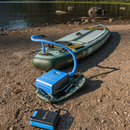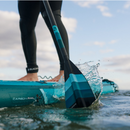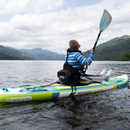Paddle Board Repair: A Comprehensive Guide

Maintaining the life of your beloved paddle board is part and parcel of the paddle boarding experience, but every small issue shouldn't keep you out of the water. Welcome to your guide on paddle board repair, a must-read for anyone who loves the water as much as their board. From tackling minor leaks in inflatable boards to mending dents in hard boards, this guide offers seamless fixes for all.
So, let’s dive in and make sure that nothing holds you back from your upcoming aquatic adventure!
How to Repair an Inflatable Paddle Board
Before we delve into the techniques of inflatable paddle board repair, let's first make sure you have all the essential tools and supplies on hand.
8 Basic Tools and Supplies for Inflatable Paddle Board Repair
Here's your checklist to prepare for the journey ahead:
- High-Pressure Pump: The paddle board pump ensures the PSI level of your board, ideally ranging from 12-15 PSI. Quality pumps usually cost between $129 to $150.
- Pressure Gauge: The pressure gauge helps you measure the current pressure level in your paddle board. It costs around $9 to 25$ and is often included in more advanced paddle board repair kits.
- Paddle Board Repair Kit: These kits commonly include patches, paddle board repair glue, and sometimes a valve wrench.
- Permanent Marker: Essential for marking leaky spots, a permanent marker is something you probably already have in your home.
- Soap Solution: Useful for identifying leaks. Combine a bit of dish soap and water in a spray bottle for an easy cleaning solution.
- Scissors or a Sharp Knife: To cut the repair patches to the right size, you'll need a pair of sharp scissors or a knife.
- Clean Cloth or Towels: It's essential to have these on hand for cleaning and drying the area you plan to repair.
- Hair Dryer or Heat Gun: Some repairs might require heat activation for the glue or patch, making a hair dryer or heat gun a helpful tool.
If you're investing in these tools separately, expect your total cost for a basic inflatable paddle board repair set-up to be around $50 to $100. However, many SUP board repair kits come with some of these essentials, which could save you some money and effort.

Inflatable Paddle Board Repair: Minor Damage and Small Leaks
Minor damage or a small leak in your inflatable paddle board can be an inconvenience but, fortunately, these are quite easy to fix. Here's how:
- Identify the Leak: First, inflate your paddle board to the recommended pressure. Using a soapy water solution, spray the surface and watch for bubbles. They'll point you to your leak.
- Mark the Spot: Use a permanent marker to outline the leaky area for easy reference.
- Prep the Area: Clean and dry the marked spot thoroughly.
- Apply Glue: Use specialized paddle board repair glue from your repair kit and apply a small amount over the leak.
- Patch It: Place a patch from your repair kit over the glued area and apply pressure for a good seal.
- Let It Dry: Allow at least 24 hours for the glue to repair the paddle board effectively.
Inflatable Paddle Board Repair: Larger Punctures and Tears

When dealing with larger punctures and tears, you'll need to employ a more intensive repair method:
- Locate the Damage: Inflate the board and use the soap solution method to find the puncture or tear.
- Clean and Dry: Prep the damaged area by cleaning and drying it thoroughly.
- Cut the Patch: Cut a patch that is larger than the damaged area.
- Apply Glue: Generously apply the paddle board repair glue to both the patch and the damaged spot.
- Heat It Up: Use a hairdryer or heat gun to warm the glue slightly, which helps it bond better.
- Seal the Patch: Press the patch firmly onto the glue-covered area and let it dry for at least 24 hours.
Inflatable Paddle Board Repair: Serious Tears or Multiple Punctures
Sometimes the damage can be too severe for a DIY fix, especially in the case of multiple punctures or significant tears. For these scenarios:
- Assess the Damage: Try to gauge the extent of the damage. If it seems too much for a simple patch job, it's best to consult a professional.
- Contact the Manufacturer: Many manufacturers offer a warranty or repair service, or at least can guide you on the best course of action.
With this knowledge on how to repair inflatable paddle board issues, you'll be self-sufficient and ready for many more adventures to come.
How to Repair a Hard Paddle Board
You can breathe new life into your hard paddle board with the right techniques and tools, from glue to repair paddle board cracks to dealing with more extensive damages that call for fiberglass paddle board repair.

Essential Tools and Supplies for Hard Paddle Board Repair
Before you delve into repairs, make sure you have these essential tools and supplies:
- Epoxy Resin: A must-have for sealing minor cracks and holding fiberglass cloth in place. Price ranges from $10-$20 per quart.
- Fiberglass Cloth: Ideal for reinforcing epoxy resin, it costs between $5-$20 per yard.
- Sandpaper: Get 80-grit, 120-grit, and 220-grit sandpaper to smooth out surfaces before and after repair. Each type is usually under $35.
- Small Paintbrushes: These are for applying epoxy resin. A set of disposable brushes can be as cheap as $3-$5.
- Masking Tape: Useful for protecting undamaged areas. A roll can cost less than $10.
- Acetone: Needed for cleaning surfaces before applying epoxy; it's priced around $10-$15 per gallon.
- Razor Blade or Knife: For cutting fiberglass cloth, use it with caution.
- Hair Dryer or Heat Gun: Optional but useful for speeding up the curing process of epoxy resin.
Hard Paddle Board Repair: Minor Damages
Minor damages are often just surface but can lead to more serious issues if not addressed:
- Cleanse the area with acetone to remove any grime.
- Sand the area lightly using 80-grit sandpaper.
- Apply a fine layer of epoxy resin with a paintbrush.
- Cure the epoxy either naturally in sunlight or speed up the process with a hairdryer.
- Finish by sanding the cured epoxy with 120-grit and 220-grit sandpaper.
Hard Paddle Board Repair: Cracks, Fins, and Layers
Sometimes your paddle board suffers more than just surface wounds. These require more attention and immediate action:
- Clean the area with acetone.
- Sand the damaged and surrounding area with 80-grit sandpaper.
- Cut a fiberglass cloth piece to fit the damage.
- Layer epoxy resin on the damage and place the fiberglass cloth over it.
- Seal with another layer of epoxy.
- Cure and sand for a sleek finish.
Hard Paddle Board Repair: Snapped Boards, Large Holes, Delamination
When you're looking at a snapped board or a gaping hole, you know you've crossed into the red zone. Consult a professional is mostly the solution; however, if you're up for a challenge, here’s your roadmap:
- Clean the damaged area with acetone.
- Remove the damaged part with precision.
- Fit a replacement part to align perfectly with the cut-out section.
- Bond using a generous amount of epoxy resin.
- Clamp the sections together to cure.
- Sand away any extra material and apply a layer of fiberglass cloth and epoxy to reinforce the area.

Your Gateway to Boundless Adventures
Becoming a paddle board repair professional does not serve as just a handy skill—it's a gateway to endless adventures on the water. Let's make complex simple with our guide, aiming to equip you with the knowledge you need, whether you're just starting out or are an experienced paddler.
For those who value quality and durability, iROCKER stands out as the brand to trust.
FAQs
A. How long does it take to repair a paddle board?
The repairs can take a few minutes to a few hours according to the level of damage. Also, it needs at least 24 hours for materials to cure.
B. Can I use my paddle board immediately after repair?
No, you should wait at least 24 hours after repair for the material to cure before using your paddle board.
C. What if I don't have prior repair experience?
If you lack prior repair experience, you can find step-by-step guides and videos online like iROCKER's tutorial video. It's always wise to consult with a professional if you are unsure.
D. Can I repair my paddle board myself or should I go to a professional?
For minor dings or punctures, DIY repair is usually sufficient. For major damage, especially on seams or rails, consulting a professional is the best solution.
E. How often should I check for damage?
Check your board before and after each use. Use the soapy water method to locate the leaks.
F. How can I make my paddle board last longer?
After each use, rinse your board with fresh water, dry it thoroughly, and store it in a cool, dry place.






